| |
|
|
|
|
|
BLUE-EYED
DARNER
Rhionaeshna multicolor
|
 |
|
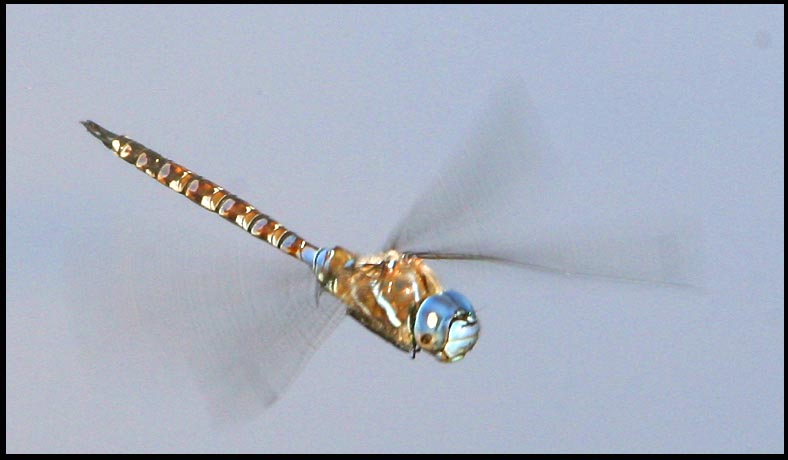
|
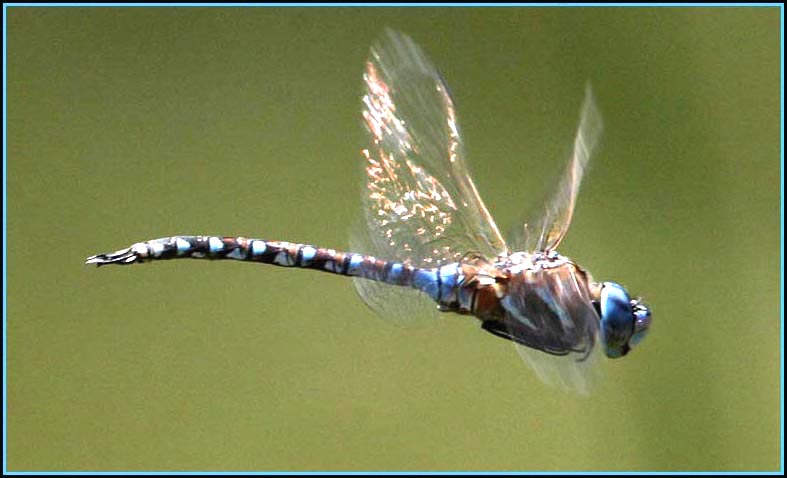
Blue-eyed Darner is a widespread and common dragonfly throughout
Monterey
County. The vast majority are males seen in flight, patrolling
territories,
like the ones above. Territories tend to be over shallow open water on
ponds, lakes, marshes, and river edges. Dragonflies are very difficult
to photograph in flight, so it took many attempts to take these images.
photos (top two
shots) 7 Oct 2006 Salinas
River near Salinas MTY
photo (directly above) 19 Sep 2006
Laguna Grande MTY
|

Perched darners are rarely observed but are a lovely treat when
encountered
(above). Males have bright blue eyes, a blue face, brown thorax with
blue
stripes, and a multicolored abdomen of brown, black, and blue.
photos (above
& below) 5 Oct 2006 Laguna
Grande MTY
Females are not often seen because they come
into the breeding
territories only to mate or lay eggs, and spend the rest of their time
away from water. It took me months to finally find a female perched
(below)
and she was quite old and beat up (notice the very ragged wings).
Females
have colorful patterns like males but typically the stripes and spots
are
green or yellow instead of blue, and the eyes can be yellow, green, or
brown.
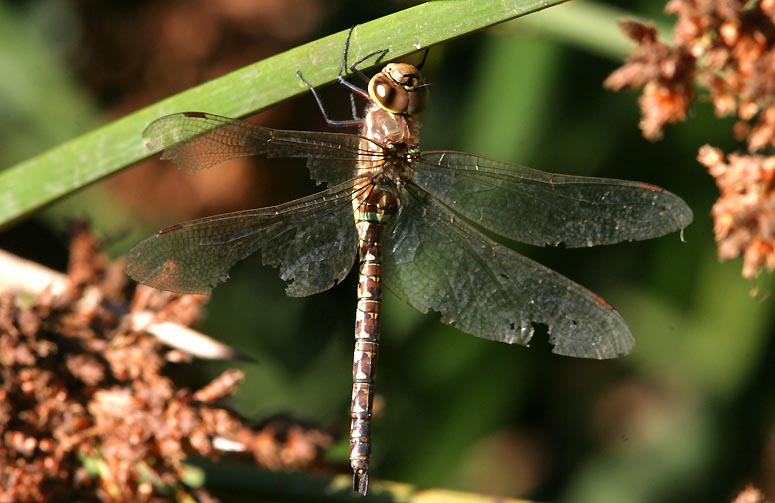
|
This captured female Blue-eyed shows in
closer detail the complex
pattern on the abdomen, the ovipositor under the 9th abdominal segment,
and the simple cerci of female darners.
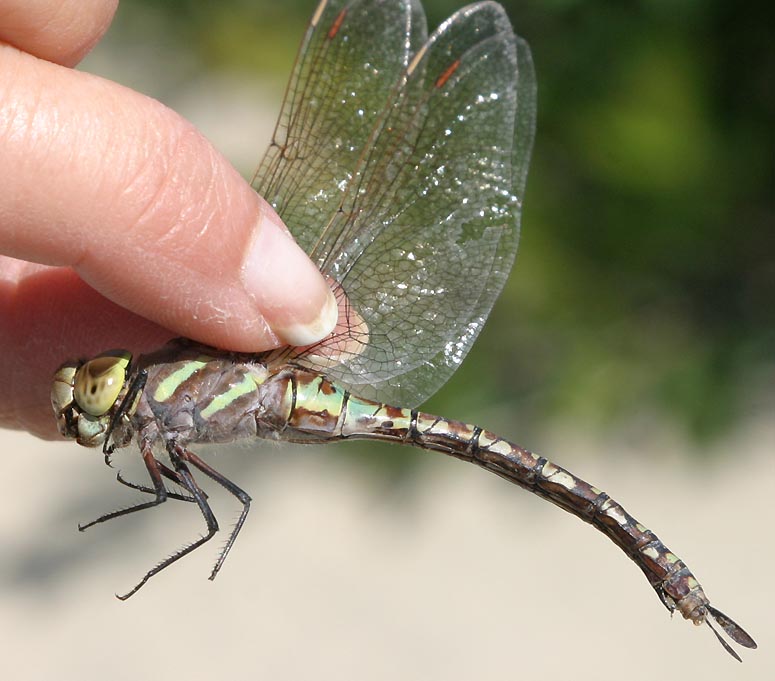
|
|
|
The male and female Blue-eyed Darners (below)
are "in wheel," or
mating, while hanging to a tule stem on a small farm pond. Note that
this
female has blue-and-brown eyes, and blue spots on her abdomen. She is
thus
more similar to male Blue-eyed Darners than the green-and-yellow
versions
shown above. Females are exceeding variable in this species. After
mating,
females primarily oviposit on their own — not guarded by the male, nor
in tandem. The ones I have observed have been ovipositing among
emergent
reeds at the edges of lakes and ponds.
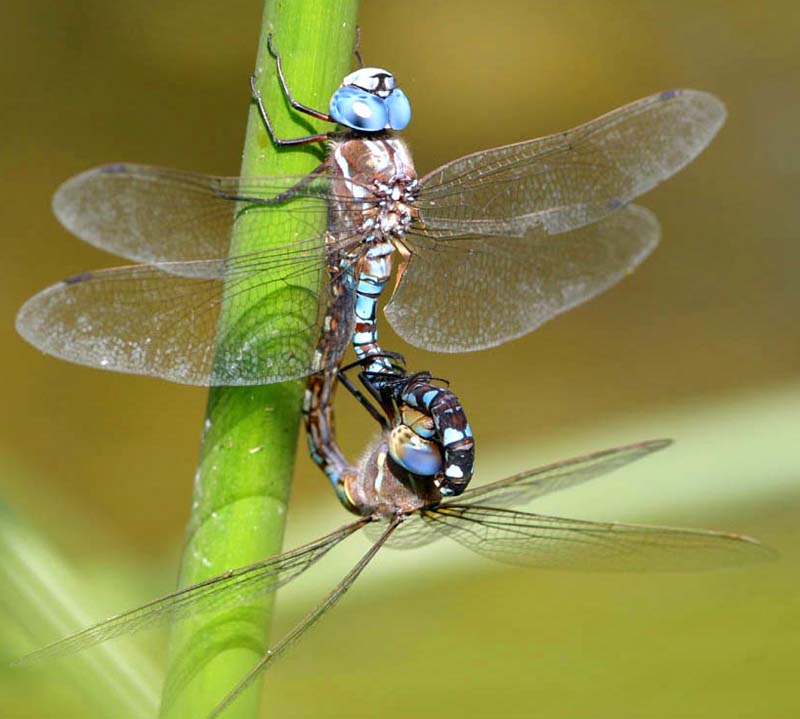
Photo (above) 10
Aug 2006 near Soledad
|
| When not patrolling mating territories, males —
as well as females
— forage widely over open country. Open grassy areas can be used as
such
feeding grounds; the shot (below) shows a male Blue-eyed Darner
foraging
over manicured lawn at Laguna Grande Park in Seaside, next to a
Wandering
Glider. On 24 July 2006, Rita Carratello and I watched over 40 darners
hunting together at Laguna Grande in huge feeding assemblages. The next
day, dozens of Blue-eyed Darners were foraging over coastal chaparral
at
Pt. Lobos State Reserve on a sunny day. |
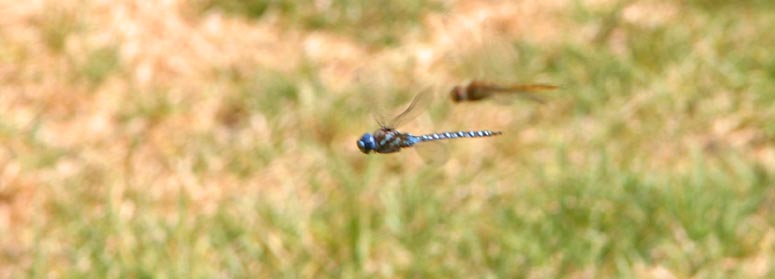
|
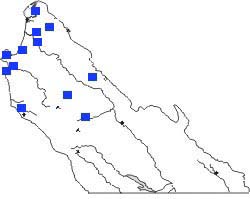 Blue-eyed
Darner is common and widespread in Monterey County. The map (right)
shows
some representative locales at which it has been recorded, but it
likely
occurs everywhere throughout the lowlands, especially around water. It
seems to generally avoid wooded and shady areas, and streams in the
mountains
appear to be dominated by Walker's Darner. Foragers and migrant
Blue-eyed
Darners could be seen anywhere, including montane ridges or even over
open
ocean. Blue-eyed Darner was the first dragonfly documented in the
county,
with one collected as long ago as 22 July 1919 (#Calif. Acadey of
Sciences). Blue-eyed
Darner is common and widespread in Monterey County. The map (right)
shows
some representative locales at which it has been recorded, but it
likely
occurs everywhere throughout the lowlands, especially around water. It
seems to generally avoid wooded and shady areas, and streams in the
mountains
appear to be dominated by Walker's Darner. Foragers and migrant
Blue-eyed
Darners could be seen anywhere, including montane ridges or even over
open
ocean. Blue-eyed Darner was the first dragonfly documented in the
county,
with one collected as long ago as 22 July 1919 (#Calif. Acadey of
Sciences).
The full flight dates of Blue-eyed Darner in
MTY are not yet documented.
To date, records stretch from 8 June-2 December, but elsewhere in
California
this species has been seen from mid-March to November (Manolis 2003).
MTY's
late date is among the latest on record in the State.
|
|
|
I was very fortunate to find a perched
Blue-eyed Darner during
my very first day out looking for odes. I took this photo (below). This
success surely helped to 'hook' me on searching for these beautiful
insects.
Photo (above) 7
July 2006 Carmel River mouth
|
|
This is a perched female right near the end
of the season: indeed,
the date (2 Dec) is among the latest documented in California. Notice
that
this particular female is andromorphic — her pattern is like a
blue-and-brown
male except for the brown eyes, brown face, and female terminal
appendage
plus vulvar spine — while the females earlier on the page were
gymomorphic
(i.e., having a distinct green-and-brown female pattern).
Photo (above) 2
Dec 2006 Carmel River mouth
|
|
Literature cited:
- Manolis, T. 2003. Dragonflies and Damselflies of
California. Univ. of
Calif.
Press, Berkeley.
Web resources:
Major identification web sites with much information on California
odes include:
For sites with excellent photos to compare for identification or to
simply
enjoy, see:
Many of these sites have links to other useful pages. Kathy Biggs's
site
is particularly useful in her selection of links. |
|
All photos © Don Roberson 2007
TOP
|
|
|
Page created 6-9
Oct 2006, updated 3 Dec 2006
|
|
|
|
|
